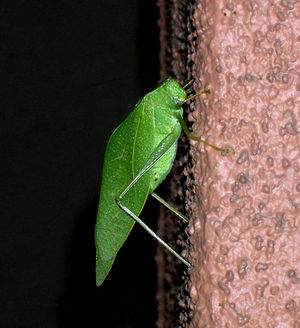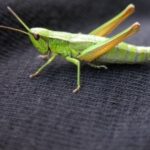Katydids, is a catch all phrase referring to the family of grasshoppers. These are fascinating creatures, as their songs lend an esoteric feel to experiencing nature and their color causes them to blend in with the flora and fauna surrounding them.
The katydid belongs to the order of Orthoptera, referring to the parallel-sided structure of the front wings and the sub-order Ensifera, of which both katydids and crickets belong to. Ensifera refers to the antenna which is as long as the body. There are families and sub families of katydids. The main two families are the hump-backed family and all others grouped together, make up the second family. As there are hundreds of species within a family, the easiest way to distinguish them is by their distinctive sound or sonogram. Some of the individual sounds they make are actually too high for us to hear. However, the lower frequencies can be captured and detected to identify the type of species the katydid belongs to.
The expression “you are what you eat,” fit’s the katydid nicely as many of the North American species disguise themselves as leaves or blades of grass, this being one of the main staples of their diet. Their legs are long and the bright green color of their wings contain membranes that appear as lines, like those on a leaf. This arrangement of nature camouflages the katydid beautifully. If a katydid is sitting on a leaf with its wings folded over it, it is hard for predators and even people sometimes to distinguish it from the plant that it is resting on.
The katydid is an important part of the natural cycle as protein sources for larger animals, including sub-tropical primates, rodents and different species of bats.
The males are crooners, as they sing their way into the hearts of the ladies, by rubbing their forewings together to create a distinctive melody. They do this by raking a file (a modified vein with teeth located on their left forewing,) over their right forewing. The ladies do the same, responding with their call. It is something to hear them sing, as they sound almost like a chorus of whisperers, with a “sshhh,” sound, but at higher volume. They sound like the whisper of nature, but louder. Many people have pleasant memories of these little music makers, as the sound tends to remind them of their childhood, or a nice vacation they were on. A final interesting note about the katydid is that they can predict the weather. They begin singing about three months before the first hard frost and after it hits, they become silent.
In general, these little bugs are quite positive, benefiting both the environment and people with their fascinating sounds, but they do bite if threatened and a few grow to a very large size. The real problem with katydids is that they will munch away on your foliage and fruits of your garden. Fortunately, there are many natural ways to stop these critters from ruining your vegetation. Here are a number of natural suggestions. Let your cat loose in your garden, they can and do eat grasshoppers. Different plants such as horehound, (Marrubium vulgare) calendula, cilantro, sweet clover and peas can all act as barriers to the little munchers. Traps, row covers and garlic sprayed on the plants as a repellent are also all effective organic methods of controlling the population of katydids. Katydids are enjoyable creatures as long as they are not decimating your little patch of fruits and flowers that has become your pride and joy.





